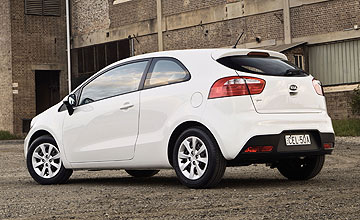BY RON HAMMERTON | 20th Apr 2012

In a word: Tyres.
This issue is clearly evident on Kia’s new Rio light car, that, despite three body styles and a selection of four equipment levels – S, Si, SLi and SLS – share common underpinnings.
And, handsome underpinnings they are too, in the main.
Right across the range, the Rio points, squirts and brakes like the next-best thing to a European hatchback, at least in the light end of the car sales pool.
It helps that much of the suspension tuning was done locally by a team including Kia’s national marketing manager Steve Watt and engineering consultant Graeme Gambold, both of whom were involved in the Kia Optima and Sportage tuning too.
At the recent launch of the cheeky three-door and sedan variants that have just joined the new-generation Rio five-door in Australian showrooms, these experts took the trouble to explain the whole process of localisation of the Rio range, in terms of suspension and steering tune.
Then it was out on to some of the same New South Wales test roads used by the team to arrive at their settings.
These roads were chosen for their variety – mainly of the bad sort – and deliver a real challenge to any car, let alone a $16,000 economobile.
First up we drove a top-of-the range three-door Rio SLS, armed with the acclaimed 1.6-litre direct-injected Gamma engine from the Hyundai group, and were immediately impressed with the pleasing Euro-style interior, complete with dusky leather trim, smart dash layout and keyless start.
Once on the move, the little hatch bolted down the road, each of the six gears easily selected with the manual gearshift that is better than most self-shifters fitted to cars in this class.
While the electric-assisted steering is better than adequate – and certainly would exceed the expectations of most Korean hatch buyers – it is not quite in the VW Polo realm.
Overall, the vehicle dynamics are just what the Kia Australia team was seeking: better than the average light car, which effectively means the Yaris, Mazda2 and Hyundai Accent.
But there is one fly in the ointment: the Kia SLS rides a little harshly on its wide but low-profile 45-section tyres fitted to 17-inch alloys, while also delivering a certain amount of road roar on course tarmac.
Next we tried the base three-door Rio S in its three-door form, again with the six-speed gearbox.
The first noticeable difference was the power downgrade, with the S armed with the smaller 1.4-litre multi-point four-cylinder engine with 25 fewer kilowatts.
Having said that, the engine remains impressive, hauling the little car along country roads with a surety of a car one size larger.
Despite rolling hills, the gears remained unchanged for much of the drive – a testament to the hearty torque of this little unit.
But compared with the smarter and more expensive Rio SLS, the entry-level S had one clear advantage: tyre roar and sharp bump harshness was noticeably less.
Yep, the S rides on meatier 65-aspect tyres, fitted to narrower 15-steel rims, putting more tyre side wall cushioning into the ride.
Of course, this is at the expense of cornering competence, but most Rio S buyers are going to be quite happy with the package.
Likewise, the Rio Si sedan that was next on our list of driving experiences came in, like Goldilock’s bed, just right.
As the middle specification in the Rio line-up, the Si's wheels and tyres – 16-inch alloys with 195/55 rubber – felt like a happy compromise between the relative harshness of the SLS’s grippy but uncompromising tyre set-up, and the softer but less sporty S wheel/tyre combo.
The sedan also offers a tremendous boot for a baby car, while the interior cabin space – especially rear legroom – is class-leading.
Of course, the hatchbacks – in three- and five-door – sit on the same long-wheelbase (for a light car) wheelbase, so they too have loads of space for two adults in the back, although the entry and egress of the three-door is naturally compromised.
The seats are a little hard and flat for our taste. While we are getting picky, we found that holding accelerator pedal just so over long distances was a little tiring on the ankle, due to its position.
All of the Rio models are dressed to impress, not just in terms of the stylish exterior design but also inside where each level has it own appropriate appointments according to price.
Each model level has equipment that applied only to expensive luxury cars not too many years ago, such as six airbags and heated outside mirrors (even on the base S).
Kia clearly has a bit of catching up to do in the image department, but the Rio three-door and sedan – along with the five-door that was launched four months earlier – is yet another leap in the right direction.